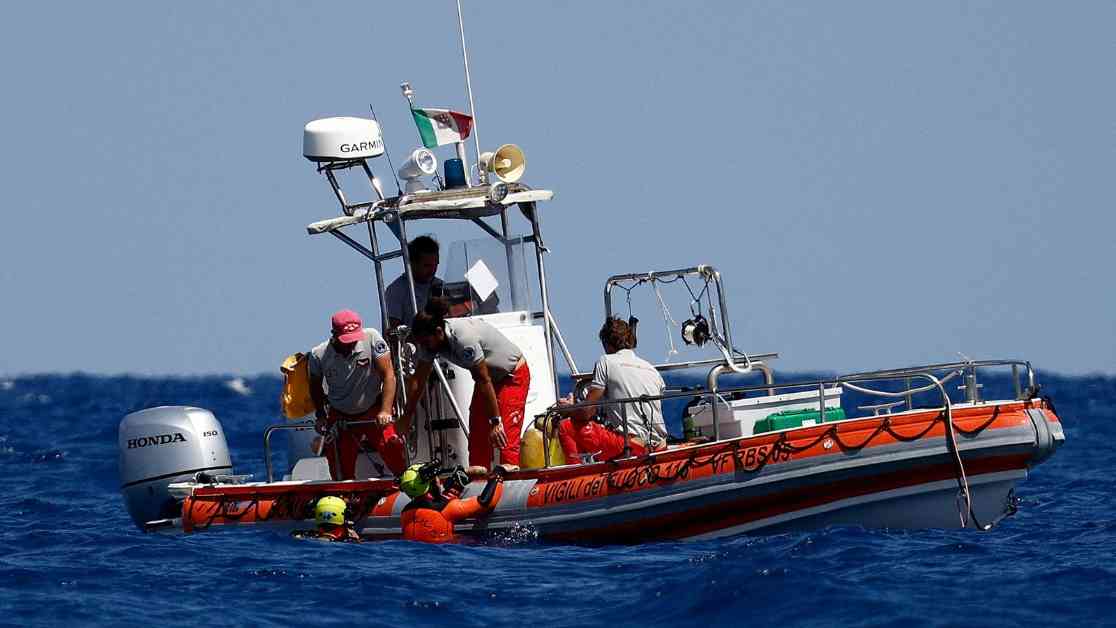The search operation to find those missing after the sinking of the Bayesian superyacht has been plagued with difficulties. Six bodies have been found after the luxury vessel went down off the coast of Sicily in the early hours of Monday, with one person still unaccounted for.
Depth of the Wreckage
Marco Tilotta, a diver coordinating the search and rescue efforts, has highlighted the challenges faced by teams working beneath the water. The British-flagged superyacht remains largely intact on the seabed but is situated at a depth of 50 meters, making access difficult for divers. This depth surpasses the qualifications of most recreational divers, necessitating special precautions.
Divers operating at such depths can only spend approximately 12 minutes underwater at a time, with a maximum of 10 minutes dedicated to actual search efforts. This limitation is crucial in preventing decompression sickness, commonly known as the “bends,” which can occur when divers ascend too quickly after prolonged periods underwater.
Simon Rogerson, the editor of SCUBA magazine, emphasized the importance of a slow ascent to combat the effects of pressure at such depths. Additionally, divers must contend with the cold and dark conditions of the water. To mitigate these challenges, a tag-team approach is being utilized, allowing divers to rotate in and out of the search area.
Entering the Yacht
Once divers reach the wreckage, they encounter further obstacles. The 56-meter-long superyacht currently lies on its right side, offering limited points of entry. Divers are unable to see inside the yacht from the exterior, adding to the complexity of the search and rescue operation.
Luca Cari from Italy’s fire and rescue department mentioned that divers managed to access the yacht through the lounge using a ladder. Reports indicate that a hole in the side of the boat was also opened for entry. Despite searching the command bridge, which contains electrical cables, no individuals were located. Divers identified a glass window as a potential entry point, although its 3cm thickness posed a challenge for removal.
Cabins Blocked by Furniture
Following the rapid sinking of the Bayesian in the early hours of Monday, rescue crews presumed that many of the 22 individuals on board were asleep in cabins below deck. However, divers have encountered difficulty accessing these areas due to furniture obstructing the passageways.
Italian media reported that two bodies were discovered hidden behind mattresses, underscoring the challenges faced by rescue teams in retrieving the missing individuals. The urgency of the situation and the need to navigate through blocked cabins have added layers of complexity to the search operation.
Specialist Divers and Underwater Technology
In addition to skilled divers, remote-controlled underwater devices have been deployed to aid in the search efforts. These advanced technologies enhance the search capabilities and provide valuable assistance in locating the missing person and gathering crucial information about the sunken superyacht.
One of the drones utilized by the Italian coastguard can operate at a depth of 50 meters for approximately two hours, offering extended underwater surveillance capabilities. An upgraded drone with enhanced endurance can remain submerged for six to seven hours at a depth of 300 meters, providing an even greater range for exploration.
Former Royal Navy submarine captain Ryan Ramsey commended the effectiveness of these drones, describing them as “amazing pieces of technology” that significantly contribute to the search mission. Dr. Jamie Pringle, a reader in forensic geoscience at Keele University, emphasized the value of underwater devices in assisting divers in determining areas for further exploration and identifying potential hazards to avoid.
The challenges faced by search and rescue teams in locating the superyacht wreck are multifaceted and require a coordinated effort to overcome. The depth of the wreckage, the orientation of the yacht, and the obstacles within the cabins all contribute to the complexity of the operation. As divers and underwater technology continue to work tirelessly in challenging conditions, the hope remains to bring closure to this tragic maritime incident.













